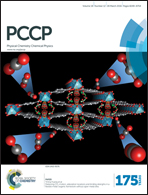Dielectric relaxation behavior in antiferroelectric metal organic framework [(CH3)2NH2][FeIIIFeII(HCOO)6] single crystals†
Abstract
The fundamental aspects of the relaxation dynamics in niccolite-type, mixed valence metal–organic framework, multiferroic [(CH3)2NH2][Fe3+Fe2+(HCOO)6] single crystals have been reported using dielectric relaxation spectroscopy covering eight decades in frequency (10−2 ≤ f ≤ 106) in the temperature range 120 K ≤ T ≤ 250 K. The compound shows antiferroelectric to paraelectric phase transition near T = 154 K with the relaxor nature of electric ordering. The temperature dependent dielectric response in modulus representation indicates three relaxation processes within the experimental window. The variable range hopping model of small polarons explains the bulk non-Debye type conductivity relaxation. The fastest relaxation with activation energy Ea = 0.17 eV is related to progressive freezing of the reorientation motions of DMA+ cations. X-ray diffraction data revealed that complete freezing of orientational and translational motions of DMA+ cations occurs well below phase transition temperature. These experimental observations are fundamentally important for the theoretical explanation of relaxation dynamics in niccolite-type metal–organic frameworks.
![Graphical abstract: Dielectric relaxation behavior in antiferroelectric metal organic framework [(CH3)2NH2][FeIIIFeII(HCOO)6] single crystals](/en/Image/Get?imageInfo.ImageType=GA&imageInfo.ImageIdentifier.ManuscriptID=C6CP00064A&imageInfo.ImageIdentifier.Year=2016)

 Please wait while we load your content...
Please wait while we load your content...